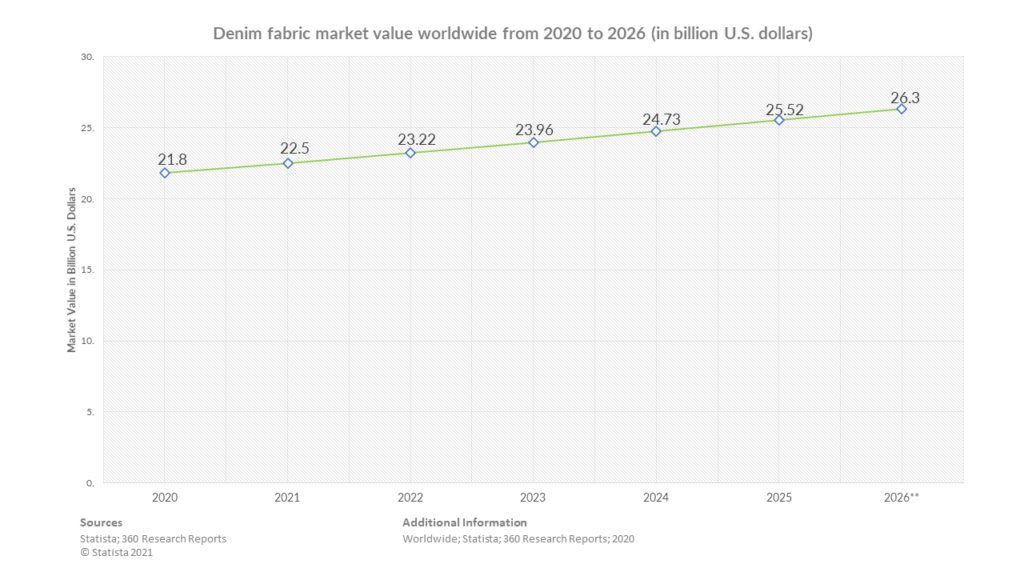Globally, the popularity of denim is increasing. You can wear denim jeans on various social and formal occasions to show their ability to transcend age and gender boundaries. As the ‘new consumerism’ shifts demand towards buyers and ethically produced fashion, one of the worst offenses in terms of human and environmental costs of production, there will be some of the best opportunities to do a healthy business out of ethical clothing production.
With denim being a staple garment of fashion and function, there are shreds of evidence of its impact on people and the environment. Their mass production, which often requires highly toxic chemicals to produce pre-faded on-trend garments, has come under particular scrutiny from regulators and organizations. As a result, clothing brands, retailers, and apparel manufacturers have rushed to quantify the commercial potential of ethical and sustainable apparel.
The greatest is to meet the growing demand for sustainable fashion while dealing with the increased cost of materials and labor to monitor supply chains and ethical production.
Denim is also not just standard jeans today, some denim trends are very creative or even straight up weird. There seem to be no limits in denim fashion.
Denim Market Value
Amidst the COVID-19 crisis, the forecasted global denim market value will reach US$21.8 Billion in 2020. It is estimated to reach US$26.3 Billion in 2026, growing at a CAGR of 4.8% during the forecast period. The forecasted offline segment will grow at a CAGR of 3.7% and reach US$60.8 Billion during the forecast period.

Despite the economic crisis, growth in the estimated online segment is to reach 9.2% CAGR for the next 7-year period. This segment makes use of 17.7% of the global denim market value. The popularity of online sales channels is being increased by more and more consumers using the Internet to browse various websites and enjoy web-based or apps-based shopping.
In addition, compared to online stores that can offer cheaper products, the physical format of these stores eliminates the requirement to face queues and encourage consumers to make online retail purchases. Offering a wide range of brands, specialty stores attract customers using strategic marketing initiatives and merchandising. Increased spending power, per capita consumption of denim jeans, awareness of body-type clothes, and acceptance of casual wear for office work are driving the growth of the global denim market value.
However, the working-from-home practice, the increasing popularity of loose-fitting clothing, and the adoption of a simple, voluntary lifestyle hamper the market growth. On the other hand, the increased disposable income in developing Asia Pacific countries, such as India and China, has increased spending on personal care and clothing. It provides new opportunities in the years to come.
The Key Factors of the Market Growth
Constant product innovation in the market and improved living standards improvement will drive product demand even further. Increased awareness of the availability of various products, such as boot cut, high rise, cropped, skinny, tapered, and regular fit jeans, also contributed to market growth. Furthermore, the increase in demand for branded clothing will also drive the denim market value growth. Changing fashion trends and designs for manufacturing remain as strong growth drivers.
The increment of casual workplace wear and youth employment bide well for the global denim apparel market. The premium jeans segment growth also drives the market value increment. Also, the aggressive promotion of innovative-styled denim clothing drives the jeans segment growth.
Furthermore, the influence of social media platforms and endorsement by celebrities and influencers will spike the denim market value growth. The growth of the global clothing market with the introduction of premium and branded products is likely to have a significant impact on the development of the denim jeans market as well. As a means to grow their sales, many large manufacturers have implemented several business strategies, such as geographic and capacity expansion, M&A, R&D and improved quality assurance processes.
Thus, this will drive the growth of the global market. Being the dominant regional market in 2018, North America is estimated to expand further with a steady CAGR from 2019 to 2025. However, Asia Pacific is expected to record the fastest CAGR during the forecast years.
The Green Revenue
As global consumers and governments become more aware of the fabric’s green footprint, some manufacturers will start looking for sustainably-produced denim. That’s why several brands have started to recycle denim fabrics to reduce their green footprint.
Some manufacturers use natural dyes and smaller barrels to refrain from using colored and bleached denim fabric. Others use yarn spurn from leftover denim waste and use the foam dyeing technique to color them instead of water.Another eco-friendly step is to use cold staining; and e-flow technology, where you will use nanobubbles and ozone to soften the needed materials, and lasers to add streaks and faded lines to denim fabrics instead of harmful bleaches.




